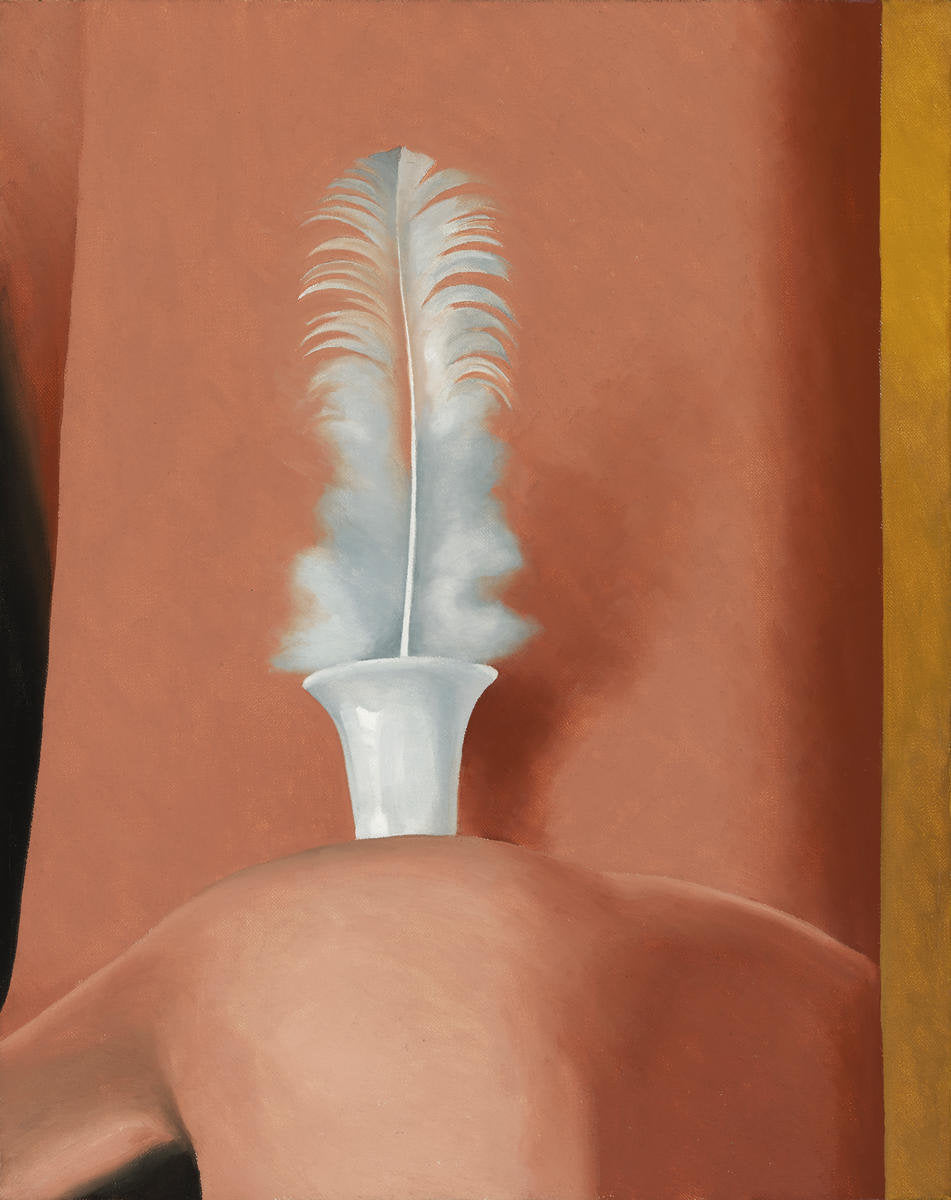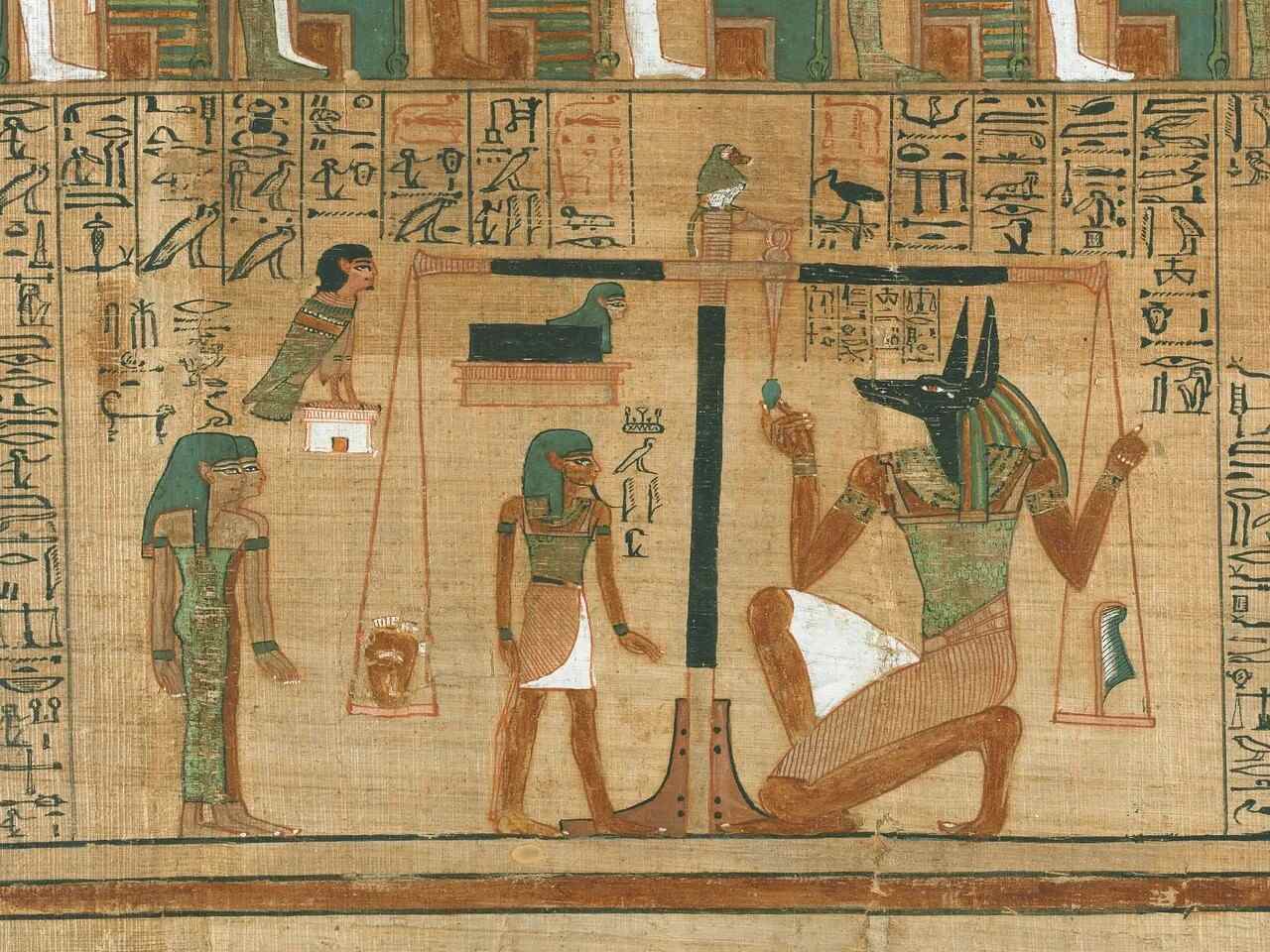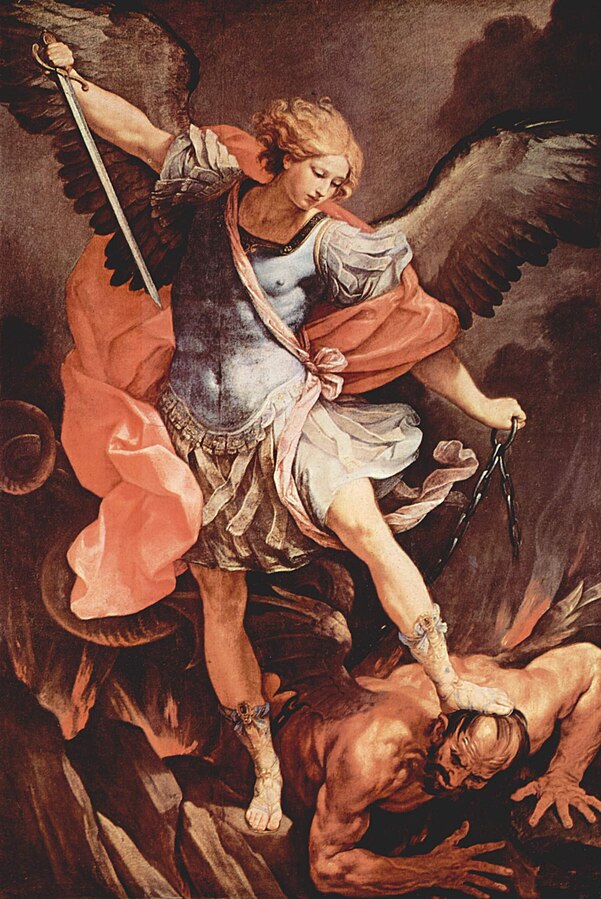Feathers have been revered for their associations with freedom, spirituality, and ascension. From ancient Egypt, where they symbolized justice and truth, to Native American traditions where they represented honor and connection to the divine, feathers have carried profound meaning. They have appeared in various art forms, literature, and jewelry, symbolizing everything from personal growth and resilience to divine protection and transcendence. The feather remains a timeless symbol of the soul’s journey and spiritual freedom.
Amuletha™ Book of Symbols
Feather Symbol
White Feather by Georgia O'Keeffe
"White Feather" by Georgia O'Keeffe is a serene and minimalist painting that embodies her signature style of abstraction and close-up perspectives. O'Keeffe's approach in this piece, like many of her works, focuses on magnifying natural forms, drawing attention to their subtle textures, shapes, and the delicate interplay of light and shadow. The painting reflects her fascination with the simplicity and purity of organic objects, using soft, flowing lines and a restrained color palette to evoke a sense of quiet contemplation and harmony.

White Feather by Georgia O'Keeffe
"White Feather" by Georgia O'Keeffe is a serene and minimalist painting that embodies her signature style of abstraction and close-up perspectives. O'Keeffe's approach in this piece, like many of her works, focuses on magnifying natural forms, drawing attention to their subtle textures, shapes, and the delicate interplay of light and shadow. The painting reflects her fascination with the simplicity and purity of organic objects, using soft, flowing lines and a restrained color palette to evoke a sense of quiet contemplation and harmony.
FEATHER SYMBOL ORIGIN
The feather is one of the oldest and most profound symbols in human history, deeply rooted in various cultures and spiritual beliefs. Its origins as a symbol trace back to ancient civilizations, where feathers were associated with the divine, particularly in the context of birds and their connection to the heavens. In Ancient Egypt, feathers were linked to Ma’at, the goddess of truth and justice, as she used an ostrich feather to weigh the souls of the dead against the truth. This powerful symbol indicated purity and fairness. In Native American culture, feathers often represented freedom, honor, and the connection between the physical and spiritual realms.
In the Roman Empire, feathers were commonly worn by soldiers on their helmets, symbolizing bravery and triumph in battle. By the Middle Ages, feathers had become a symbol of nobility, commonly used in heraldry to denote both rank and valor. As centuries passed, feathers became more connected to ideas of communication with higher powers, particularly through dreams, due to their lightness and ability to float on air, representing the soul's transcendence.
Through various epochs, the feather has maintained its spiritual significance. For many cultures, it embodies the concept of ascension and the pursuit of higher knowledge. Its graphic history can be seen in various ancient and medieval art forms, where feathers were depicted in divine or regal contexts. Today, it is still viewed as a symbol of spiritual journeys, serving as a reminder of one's connection to the spiritual world.
What does feather symbolize
While the feather symbol carries numerous meanings, these four are the most universally recognized and embraced:
Freedom
Feathers are often associated with birds and the ability to soar through the sky, representing freedom from earthly constraints and limitations.
Spirituality
In many cultures, feathers symbolize a connection to the divine or spiritual realms, acting as messengers from the gods or the heavens.
Ascension
Feathers represent the soul’s rise to higher spiritual realms and transcendence beyond earthly limits.
Strength
Despite their lightness, feathers can also symbolize strength and resilience, particularly in Native American and warrior traditions, where they are seen as a badge of honor and bravery.
Cultural mention
Throughout history, feathers have consistently symbolized freedom, spirituality, ascension, and strength across various cultures. Their lightness and ability to soar through the skies made them powerful metaphors for the soul's journey toward higher realms, spiritual freedom, and divine connection. From ancient civilizations to modern-day practices, feathers have embodied these core ideas, often representing the soul’s desire to rise above earthly limitations and achieve spiritual enlightenment. In this section, we’ll explore how feathers have been revered across different traditions, always connected to these enduring themes of transcendence and inner strength.
The Feather of Ma'at in Ancient Egypt
In Ancient Egypt, the feather was deeply intertwined with the concept of divine justice, especially through the feather of Ma'at, the goddess who personified truth, order, and balance. During the pivotal "Weighing of the Heart" ceremony, which determined a soul's worthiness for the afterlife, the deceased’s heart was placed on a scale and balanced against Ma'at’s feather. The feather, symbolizing the purity of the soul, dictated whether the individual had lived a just and moral life. A heart lighter than the feather granted the soul entry into the eternal paradise of the Field of Reeds, a serene afterlife. However, if the heart was weighed down by guilt or wrongdoing, it was consumed by the fearsome deity Ammit, leading to the soul’s obliteration. This profound association between the feather and truth cemented its role as one of the most sacred symbols in Ancient Egyptian culture, representing the eternal quest for justice and balance in both life and death.
*The Weighing of the Heart Ceremony, Papyrus of Ani 1250 BC.

*The Weighing of the Heart Ceremony, Papyrus of Ani 1250 BC.
Feathers in Indigenous American Traditions
In Native American cultures, feathers held immense spiritual significance, often regarded as gifts from the divine. Eagle feathers, in particular, were revered as sacred, symbolizing strength, wisdom, and a direct connection to the Creator. These feathers were not merely decorative but embodied the virtues of the bird from which they came. Eagles, soaring high above the earth, were seen as messengers between the physical world and the spiritual realm. For many tribes, receiving an eagle feather was among the highest honors, awarded to warriors and leaders for acts of bravery, wisdom, or exceptional leadership. The feathers were incorporated into sacred rituals, prayer sticks, and ceremonial attire, functioning as powerful tools for spiritual communication. Feathers also played a role in healing practices and were believed to offer protection, serving as a conduit for the spirits to guide and watch over the wearer. The feather, in this sense, was far more than a symbol of prestige; it represented a deep bond between humans and the spiritual forces of the natural world.
*Victory Dancer by Z.S. Liang

*Victory Dancer by Z.S. Liang
The Feather as a Symbol of Freedom in Christian Tradition
In Christianity, feathers symbolize freedom, spiritual ascension, and divine protection, often depicted alongside angels to represent the soul’s connection to the divine. Angels, shown with feathered wings, served as God’s messengers and guardians, symbolizing the lightness of the soul rising toward heaven, free from the burdens of earthly life. Feathers were also associated with purity and martyrdom, as they often appeared in depictions of saints and martyrs, signifying their souls' ascent to eternal salvation. Psalm 91:4 reinforced this imagery, stating, "He will cover you with His feathers, and under His wings, you will find refuge," solidifying the feather as a metaphor for God's protection and the soul’s journey toward spiritual freedom. The feather’s light, ethereal quality made it a fitting symbol of the soul’s release from the physical world and its ascension to divine grace.
The Archangel Michael Defeating Satan by Guido Reni (1636)

The Archangel Michael Defeating Satan by Guido Reni (1636)
FEATHER SYMBOL IN THE WORLD OF JEWELRY
Feather jewelry often appeals to individuals seeking a connection to spirituality, freedom, and personal growth. The symbol resonates with people who appreciate nature, as well as those who embrace a bohemian or free-spirited lifestyle. Typically, younger audiences, particularly those drawn to ethereal or natural themes, are the most common wearers. Additionally, those with a deep interest in Native American culture or spiritual symbolism might wear feather jewelry as a sign of respect or as a talisman. People often wear feather jewelry to express their desire for freedom, hope, or guidance, with the feather serving as a reminder of lightness and the possibility of rising above challenges. The feather’s religious connotations, often linked to protection or ascension, are also a key reason why individuals choose it.When gifted, feather jewelry carries a significant and heartfelt message. It often represents a wish for spiritual protection, peace, or guidance for the recipient. Giving someone a feather symbol as a gift may symbolize offering freedom from burdens or wishing them strength and clarity on their personal journey. It is also seen as a gesture of encouragement, expressing the hope that the recipient will soar toward their goals or dreams. In spiritual traditions, gifting a feather can signify the desire for the recipient to be watched over by higher powers or to be reminded of their inner strength. Such gifts are common in situations where a person is entering a new phase of life, like a graduation, a new job, or a significant personal transformation.
Feather SYMBOL IN LITERATURE
The feather symbol has long appeared in literature, representing themes of freedom, spirituality, and transcendence. Associated with lightness and flight, feathers are used to depict the soul’s journey, liberation, or divine intervention. From poetry to fiction, feathers symbolize transformation, the search for truth, or spiritual awakening. They often appear in works that explore the balance between the physical and metaphysical realms, where the feather embodies the delicate and ethereal nature of human experience.
“Forrest Gump” by Winston Groom
One of the most prominent literary works that features the feather is Forrest Gump by Winston Groom. In both the novel and the film, the feather symbolizes life's unpredictability and how humans are often carried by unseen forces. Floating on the wind, the feather suggests that life is full of random events beyond one’s control, while also reflecting the theme of fate versus free will. As Forrest drifts through life, the feather underscores his journey, where destiny and personal choices intertwine.
Book cover featuring Tom Hanks, playing Forest Gump in the 1994 film by Robert Zemeckis

"Hope is the Thing with Feathers" by Emily Dickinson
Hope is the thing with feathers
That perches in the soul,
And sings the tune without the words,
And never stops at all.
In this poem, the feather represents hope. Dickinson uses the feather metaphor to show how hope, like a bird, resides within the soul and continues to sing, offering comfort and resilience, no matter the circumstances.
"Ode to a Nightingale" by John Keats
Thou wast not born for death, immortal Bird!
No hungry generations tread thee down;
The voice I hear this passing night was heard
In ancient days by emperor and clown.
Here, Keats invokes the nightingale as a symbol of immortality, with the bird’s feathers representing the soul’s yearning for freedom and transcendence. The bird’s song echoes through time, reflecting the poet's longing to escape the mortal world and its sufferings.
"To a Skylark" by Percy Bysshe Shelley
Higher still and higher
From the earth thou springest
Like a cloud of fire;
The blue deep thou wingest.
In this ode, Shelley uses the skylark’s flight as a symbol of pure inspiration and freedom. The feather represents the bird’s ability to soar high above the earth, reflecting the poet’s aspiration to transcend earthly limits and reach the heights of creativity and thought.
Thoughts
Thoughts placed alongside a symbol resonate with its meaning, serving as a guide to expand your understanding of the symbol's significance in relation to your personal experiences. AMULETHA™ also embraces this approach, invites a deeper contemplation of how symbolic meanings can reflect and enrich your life’s narrative, enhancing your appreciation of both the symbol and its broader implications.
Ethereal Flight - Feathers carry the soul beyond the earthly plane, symbolizing the spirit’s journey to freedom in realms unseen.
Whispers of the Divine - Fallen from the heavens, delicate signs of guidance, connecting the mortal world to the mysteries of the sacred.
Ascendant Light - Holding the energy of transcendence, lifting the soul toward celestial heights, beyond the grasp of the material.
Warrior's Spirit - Feathers, fragile yet powerful, embody the quiet strength and valor of those who walk between worlds, bearing marks of courage and honor.
FREQUENTLY ASKED QUESTIONS
How does the feather relate to personal growth?
The feather is often seen as a symbol of personal growth because it represents lightness, freedom, and the ability to rise above challenges. As birds shed feathers to grow new ones, the feather signifies letting go of old patterns or limitations to make space for new development. It can also symbolize spiritual awakening, wisdom gained through experience, and the courage to pursue one’s higher purpose. Feathers remind us of the journey toward self-improvement and embracing the changes necessary for growth.
What is feather made out of?
Feathers are made primarily of a protein called keratin, the same substance that makes up human hair and nails. They consist of a central shaft, known as the rachis, with barbs extending from it. These barbs are further divided into smaller barbules that interlock, creating a strong yet flexible structure. This intricate design allows feathers to be lightweight, durable, and efficient for insulation, waterproofing, and flight in birds.
Which animal has the largest feathers?
The animal with the biggest feathers is the ostrich. Ostriches have the largest feathers of any bird species, with some of their plumes reaching lengths of over a meter (around 3 feet). Their large feathers are primarily used for insulation and display, rather than flight, as ostriches are flightless birds. The ostrich is the largest living bird, and its feathers reflect its size and grandeur.
What is heavier, a ton of feathers or a ton of bricks? :)
A ton of feathers and a ton of bricks weigh the same—both are one ton. The key difference lies in their density and volume; feathers are much lighter individually, so it would take a significantly larger volume of feathers to make up a ton compared to bricks. However, the weight of both would be equal.













